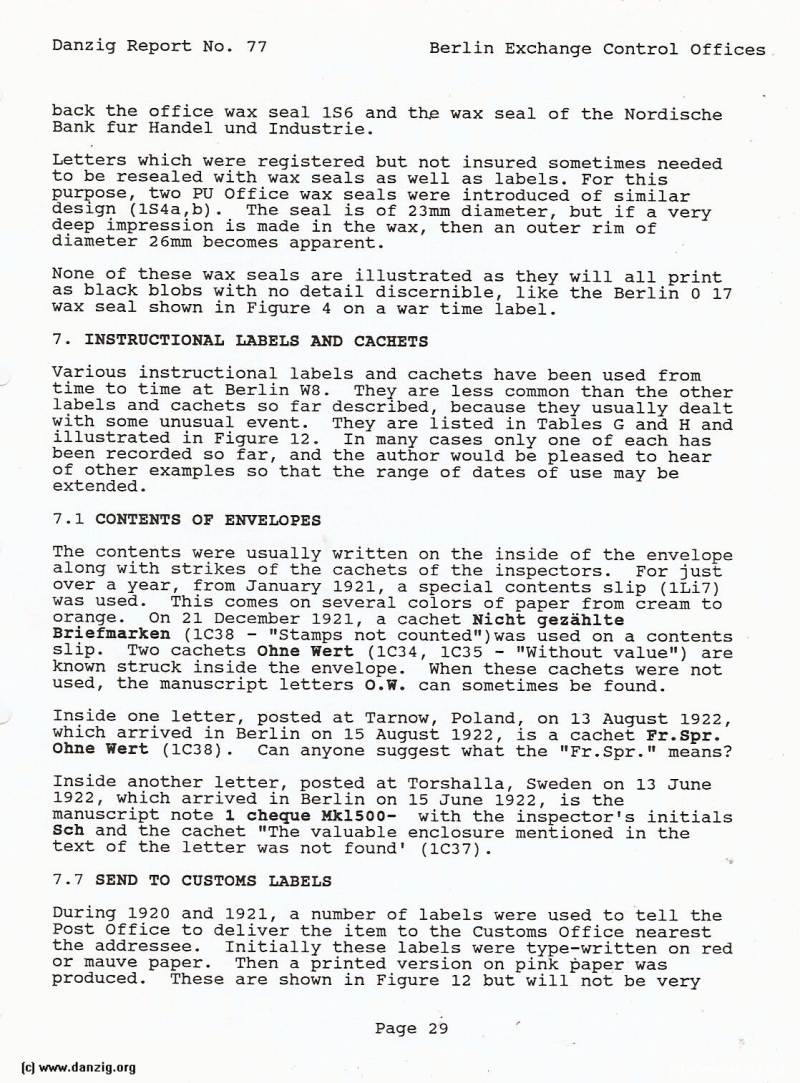
back the office wax seal 1S6 and th wax seal of the Nordische Bank fur Handel und Industrie.
Letters which were registered but not insured sometimes needed to be resealed with wax seals as well as labels. For this purpose, two PU Office wax seals were introduced of similar design (lS4a,b). The seal is of 23mm diameter, but if a very deep impression is made in the wax, then an outer rim of diameter 26mm becomes apparent.
None of these wax seals are illustrated as they will all print as black blobs with no detail discernible, like the Berlin 0 17 wax seal shown in Figure 4 on a war time label.
7. INSTRUCTIONAL LABELS AND CACHETS
Various instructional labels and cachets have been used from time to time at Berlin W8. The’ are less common than the other labels and cachets so far described, because they usually dealt with some unusual event. They are listed in Tables G and H and illustrated in Figure 12. In many cases only one of each has been recorded so far, and the author would be pleased to hear of other examples so that the range of dates of use may be extended.
7.1 CONTENTS OF ENVELOPES
The contents were usually written on the inside of the envelope along with strikes of the cachets of the inspectors. For just over a year, from January 1921, a special contents slip (lLi7) was used. This comes on several colors of paper from cream to orange. On 21 December 1921, a cachet Nicht gezählte Briefmaricen (lC38 — “Stamps not counted”)was used on a contents slip. Two cachets Ohne Wert (1C34, 1C35 - “Without value”) are known struck inside the envelope. When these cachets were not used, the manuscript letters O.W. can sometimes be found.
Inside one letter, posted at Tarnow, Poland, on 13 August 1922, which arrived in Berlin on 15 August 1922, is a cachet Fr.Spr. Ohne Wert (1C38). Can anyone suggest what the “Fr.Spr.” means? Inside another letter, posted at Torshalla, Sweden on 13 June 1922, which arrived in Berlin on 15 June 1922, is the manuscript note 1. cheque Mk1500- with the inspector’s initials Sch and the cachet “The valuable enclosure mentioned in the text of the letter was not found’ (1C37).
7.7 SEND TO CUSTOMS LABELS
During 1920 and 1921, a number of labels were used to tell the Post Office to deliver the item to the Customs Office nearest the addressee. Initially these labels were type-written on red or mauve paper. Then a printed version on pink paper was produced. These are shown in Figure 12 but will not be very
Danzig Report Vol. 1 - Nr. 77 - October - November - December - 1992, Page 29.
Hits: 1389
Added: 03/07/2015
Copyright: 2024 Danzig.org

